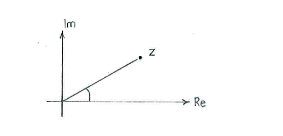Lösung 3.2:6a
Aus Online Mathematik Brückenkurs 2
(Unterschied zwischen Versionen)
| (Der Versionsvergleich bezieht 4 dazwischen liegende Versionen mit ein.) | |||
| Zeile 1: | Zeile 1: | ||
| - | + | Die Polarform ist nur eine Art komplexe Zahlen zu schreiben. Nachdem ein Vektor eindeutig durch seinen Betrag und Argument (Winkel) definiert ist, gilt dasselbe auch für komplexe Zahlen. | |
[[Image:3_2_6_a.gif|center]] | [[Image:3_2_6_a.gif|center]] | ||
| + | Anstatt der komplexen Zahl in der Form | ||
| + | <math>x+iy</math>, schreiben wir sie in Polarform, um unter anderen Multiplikation und Division zu erleichtern. | ||
| - | + | Die Polarform wird definiert durch: | |
| - | + | ||
| - | + | {{Abgesetzte Formel||<math>x+iy=r(\cos\alpha + i\sin\alpha)\,,</math>}} | |
| + | wobei <math>x</math> und <math>y</math> reelle Zahlen sind und <math>r</math> und <math>\alpha</math> der Betrag und das Argument sind. Die rechte Seite der Formen benennt man die Polarform einer komplexen Zahl. | ||
| - | <math> | + | Die Zahl 3 hat den Betrag 3 und das Argument <math>0</math>, nachdem sie auf der reellen Achse liegt. Daher ist |
| - | + | {{Abgesetzte Formel||<math>3(\cos 0 + i\sin 0)\,\textrm{.}</math>}} | |
| - | + | ||
| - | + | ||
| - | + | ||
| - | + | ||
| - | + | ||
| - | + | ||
| - | <math>\ | + | |
| - | + | ||
| - | + | ||
| - | + | ||
| - | + | ||
| - | + | ||
| - | + | ||
| - | + | ||
Aktuelle Version
Die Polarform ist nur eine Art komplexe Zahlen zu schreiben. Nachdem ein Vektor eindeutig durch seinen Betrag und Argument (Winkel) definiert ist, gilt dasselbe auch für komplexe Zahlen.
Anstatt der komplexen Zahl in der Form \displaystyle x+iy, schreiben wir sie in Polarform, um unter anderen Multiplikation und Division zu erleichtern.
Die Polarform wird definiert durch:
| \displaystyle x+iy=r(\cos\alpha + i\sin\alpha)\,, |
wobei \displaystyle x und \displaystyle y reelle Zahlen sind und \displaystyle r und \displaystyle \alpha der Betrag und das Argument sind. Die rechte Seite der Formen benennt man die Polarform einer komplexen Zahl.
Die Zahl 3 hat den Betrag 3 und das Argument \displaystyle 0, nachdem sie auf der reellen Achse liegt. Daher ist
| \displaystyle 3(\cos 0 + i\sin 0)\,\textrm{.} |

